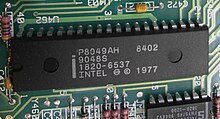
Back MCS-48 Czech Intel MCS-48 German Intel MCS-48 Spanish MCS-48 French Intel MCS-48 Hungarian Intel MCS-48 Italian Intel MCS-48 Japanese Intel MCS-48 Polish Intel MCS-48 Portuguese MCS-48 Russian




| |||||||||||||||||||||||||||||||||||||||||||||||||||||||||||||||||||||||||||||||||||||||||||||||||
The MCS-48 microcontroller series, Intel's first microcontroller, was originally released in 1976. Its first members were 8048, 8035 and 8748. The 8048[1] is arguably the most prominent member of the family. Initially, this family was produced using NMOS (n-type metal–oxide–semiconductor) technology. In the early 1980s, it became available in CMOS technology. It was manufactured into the 1990s to support older designs that still used it.
The MCS-48 series has a modified Harvard architecture, with internal or external program ROM and 64 to 256 bytes of internal (on-chip) RAM. The I/O is mapped into its own address space, separate from programs and data.
Though the MCS-48 series was eventually replaced by the very successful MCS-51 series, it remained quite popular even by the year 2000 due to its low cost, wide availability, memory-efficient one-byte instruction set, and mature development tools. Because of this, it is used in high-volume, cost-sensitive consumer electronics devices such as TV remotes, computer keyboards, and toys.
- ^ Laws, David; Blume Jr., Henry; Ekiss, John; Feng, Yung; Kline, Barbara; Raphael, Howard; Stamm, David (2008-07-30). Oral History Panel on the Development and Promotion of the Intel 8048 Microcontroller (PDF). Archived from the original (PDF) on 2014-12-27.
© MMXXIII Rich X Search. We shall prevail. All rights reserved. Rich X Search